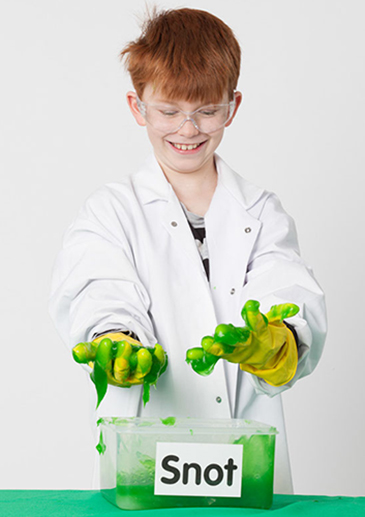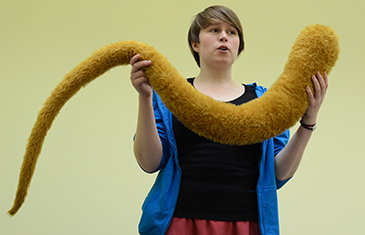Delivering Effective Science Shows and Outreach Activities

By Learning and Outreach Officers Rebecca Knowlson and Alex Jenkin
Centre of the Cell is the first science education centre in the world to be located within working biomedical research laboratories. The centre, which celebrated its 5th year of operation and 100,000th participant earlier this year, offers educational visits to its distinctive orange Pod in the Blizard Institute and runs a successful outreach programme, delivering workshops and shows to school groups. Centre of the Cell also provides online resources, mentoring and revision programmes, work experience and volunteering opportunities.
In this blog we will focus on our outreach programme, discussing the techniques we use to communicate complex scientific ideas to students, giving examples from our Snot, Sick and Scabs show. If you have any questions or comments then feel free to use the comments section at the bottom of the page.
How our shows teach scientific concepts
Our shows aim to support teaching and communicate challenging topics in a clear and engaging way. There are a number of techniques we use that we think are effective tools for teaching children science.
Demonstrations
Our demonstrations are interactive prop-based activities that require the audience to participate and volunteers to come up and assist the presenters.
We have a number of demonstrations in Snot, Sick and Scabs but our favourite is the snot demonstration. The learning aim of this demonstration is that snot is useful to us because it stops unwanted things (such as dust, pollen, dead skin cells, bacteria and viruses) from getting into our bodies and making us unwell. Firstly, we give a volunteer a lab-coat and goggles to make them feel like a scientist. Few primary schools have laboratories so for primary school students wearing a lab coat and goggles is new and exciting. Once they are kitted out we give them a washing up glove to wear to prepare them for the messy part!

The demonstration tests out different substances to find out how good they would be at stopping nasty things getting into our body if they were up our nose. The volunteer puts their hand in a substance and then into a bowl of feathers, which represent the nasty things that we don’t want to breathe in. The best substance will result in lots of feathers sticking to the glove. We test out air, water (as snot is around 80% water) and then we try something a little stickier…snot! As you will have guessed, loads of feathers stick to the snotty glove, showing that snot is the best substance to have up our noses. This is because the nasty things in the air get stuck to it and don’t get inside our lungs and make us unwell. Our snot recipe is a closely guarded secret!
By scaling up what is happening in the body and using props to represent this, the students can visualise something that normally can’t be seen, aiding their understanding. Our other shows include demonstrations which explain scientific concepts in this way, including how blood moves around the body and how sound travels.
Team games
These games aim to test the audience on their knowledge of something that has been explained by the presenter already. In Snot, Sick and Scabs, the team game is Sort the Cells. At this point in the show, the presenter will have explained what cells, bacteria and viruses are and given examples that are either good or bad for your body. For example, Acidophilus is a bacterium found in your gut that aids digestion and so is an example of a good bacteria. There are also lots of bad bacteria that can make you ill, for example Tuberculosis and Salmonella.
In this team game, two volunteers sort out cells, bacteria and viruses into baskets labelled ‘good’ and ‘bad’. It’s a race against the other team and the clock to get the most correct answers in the given time. To involve everyone, we divide the audience into two teams and ask them to cheer their player on and shout out ‘GOOD!’ or ‘BAD!’ to help them out.
We have similar team games in our other shows and all of them reinforce the concepts explained by the presenter. They also add an element of competition and fun into the shows, ensuring the students remain engaged.
Disgusting facts and disgusting props
All of our shows are full of fun facts. In Snot, Sick and Scabs we explain that if a sneeze was in a race with a cheetah then the sneeze would win as a cheetah can run at 70mph but a sneeze comes out of your nose at 100mph! These facts are memorable because they put the science into context for our audience and the answers might just surprise them too.

Many of our interesting facts are accompanied by props that help to strengthen our explanation. For example, our giant hair (which we imagine is a really big hair on the back of a really big hand) helps us to put into perspective just how small cells, bacteria and viruses actually are.
We offer a range of shows and workshops for different age groups that can be delivered by our staff onsite or in schools. See the full list of our workshops and shows here.
As well as our existing shows, we also have a number of new shows in development. This includes a genetics show for Key Stage 5, a show on digestion for Key Stages 2 and 3, a show on muscles and bones for Key Stages 2 and 3 and a show about traumatic injury for Key Stages 4 and 5. These shows will be available in the next academic year. We regularly collaborate with QMUL scientists when developing new material. If you are interested in working with us, please get in touch.
Written by Rebecca Knowlson and Alex Jenkin
Learning and Outreach Officers
Centre of the Cell